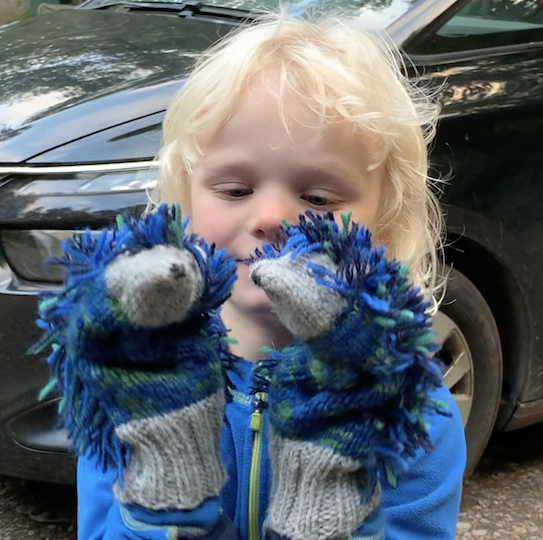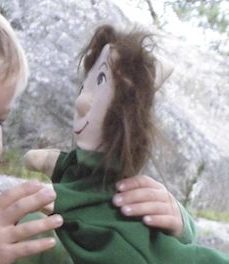I first got into puppets as a child when I attended a holiday camp and was involved in making puppets for a performance of Treasure Island. As a countryside ranger, one of my jobs was to work alongside a professional puppeteer, Sylvia Troon, during a holiday club for local children. She was brilliant and taught me so much about the joy and capacity of a puppet to support children socially, physically and intellectually of all ages and abilities. You can read her story and some of her advice in this article.

For teachers and practitioners, using puppets works effectively outdoors. Generally, the same approaches work well inside or out. Here’s 10 suggestions about using puppets with children…
1. Puppets can encourage shy children to come out of their shells
Each puppet has their own personality and it this could help enhance the children’s imagination. Modelling positive ways of using a puppet and then leaving the puppet available for children to use can be a useful springboard into a child playing with the puppet later on. Remember puppets can be silent and just nod or shake their heads. Some have special voices. Some don’t.
2. Tell stories with a puppet
Use a puppet when you have story time. This is a very effective approach to engaging some children. The puppet could model helping the reader of the story. For example, the puppet can listen carefully. Most puppets are able to do this really well, sitting or lying still and looking at what is happening or listening quietly. They can turn the pages and use a stick to point to words as they are read aloud. The puppet can tell the story instead of the teacher but I’ve found this hard going. They work well for simple oral stories.

3. Play hide and seek with puppets
You can hide the puppet outside and the children have to find it. You can have maps and clues and decide whether children will find treasure at the end. Likewise, the puppet can guide the children with clues.
4. Use puppets as a medium for conveying environmental messages
Puppets can be used in outdoors to help get key environmental messages across to the children. For example, if a puppet tells a story about how he or she got hurt by some litter left outside and has the idea to pick it up, then children are more likely to join in and also remember why it is not okay to litter.

5. The puppet as a tour guide
Children tend to listen to soft toys and puppets more than adults, so when going on a school excursion or visiting local greenspace, it may work well to take a puppet and use that for showing around places and emphasising safety points.
6. Use British wildlife puppets
It is a sad fact of life that children often know more about pandas, penguins and dinosaurs than they do about wildlife that is in their local area. Schools and nurseries can make a positive difference by using British wildlife puppets as a way of learning about the real creatures. For example, in one nursery I visited, the children had found a hedgehog puppet outside. They created a home for it, put out food and have learned all sorts about hedgehog. Every morning the first thing several children do is check on their hedgehog puppet that lives outside.Taking care of the puppet as well can help children realise that they can look after other animals too.
7. Befriend a puppet
The children can treat a puppet like a friend. Maybe for some children the puppet is there to listen to if they don’t want to tell anyone else. They can decide what the puppet may like to play with outside or where the best place is to be alone, or have snack, or see wildlife outside. This is one way of finding out children’s thoughts and opinions about their outdoor space.
8. Use the puppet as a positive behaviour strategy
Modelling how to use a puppet and appropriate behaviour is really important. Unfortunately the stereotype of Punch and Judy hitting each other has lasted far too long. Thus some children genuinely do not realise that puppets can behave well and express a full range of emotions beyond hate, anger and bullying. It’s always worth having a quiet, gentle word with the puppet first, or using a distraction to help them move away from their unwanted behaviour. Always focus on the puppet’s behaviour and not the child’s. As a last resort, If the puppet can’t manage to behave appropriately, then put just that one away whilst the other puppets play. Remember there’s always another day that a puppet can come and play.
9. Make puppets
The value of children making their own puppets, and adults too, cannot be overstated. It is very interesting, as simple or as complex as you want, creative and you can always use repurposed materials. These can reflect every child’s individual personality and they will also be using their imagination when they are making their puppet. Things I’ve found helpful include:
- Use bright fluorescent coloured card for the eyes and mouth.
- Recycle unwanted household items. For example, the spiky bits inside egg boxes make super noses. Old tights can be stuffed with newspaper to make heads.
- Cut fingers off gloves for finger puppets.
- Use old socks for sock puppets. These are especially good for outdoor use in winter time when the puppets will keep children’s hands warm.
- Add permanent marker pen markings to waterproof mittens to turn them into fish or other warm puppets.
10. Let children create their own puppet shows
You can get the children to create their own shows with the puppet, which can help them with writing a script and using their imaginations. Start with very short productions – 30 seconds or 1-minute micro-performances. With very young children, leave a box of puppets outside in a den and listen to the impromptu role play which happens.
Several years ago the Handmade Theatre Company created a puppet show, Flying the Nest. Aside from the humour and costumes, their short video shows a great range of puppets, props and ideas for creative work on a bird theme outdoors. Spot the huge willow nest!
I got in touch with the Creative Producer, Suzy Gunn and asked a few questions, which she kindly answered:
What inspired you to create a puppet show about native birds? After all surely Big Bird on Sesame Street has got the limelight. Is it possible to steal this?
Our show: Flying Machine took our imaginations flying across the world, likewise birds fly across the sky. Many children are intrigued by such fascinating creatures. They all want to know what make and model each bird is. Children love puppet shows too, so combining a love of birds with puppetry made a lot of sense. Move over Big Bird. There’s space in the nest for other birds.
Why outdoors? Surely puppet shows are indoor events all about Punch and Judy hitting each other?
Outdoors is a breath of fresh air for children and their parents. We thought that it would be appropriate with the theme of native birds. We also have a background in outdoor performances. We love the way that people can engage as much or as little as they like. They can choose to linger at the back and watch from afar or they can fully immerse themselves in the experience by sitting in a nest. There are many ways of working outside with puppets.
How did you invent such a clever piece of work? Who is the mastermind geniuses behind the props, the story, the scenery and all this jazz?
Thanks! At HandMade we are very lucky to work with a talented bunch of artists. Creating shows are a lot of work and many people work behind the scenes. The acknowledgements below give you a flavour of this:
- Ben Thomas – a natural talent. He works with a Charity who helps adults with learning difficulties to get hands on with wood work.
- Emily Croxford – Designer of interactive birds. These birds bring an amazing element to the show.
- Amy Nicholson – the puppet maker. Amy is the director of the company and everyone’s imagination came to life when the puppets were made.
What top tips and advice can you give teachers and others who work with children about creating interactive outdoor performances?
As performers, we want to mirror the children’s thoughts in the performance, so we started from the bottom by doing small workshops with children and they able to input their ideas. Listening to the young creative minds and imaginations of children enhances the creative side of children’s outdoor theatre. Our audience is children – we aim to please them.
As you can see the responses above are really helpful for considering puppets and performances outside. Enjoy and be inspired!
This blog post is an update of one originally published in January 2015.




















nice blogging laura enjoyed the video
What a great post – so many ideas on how to use puppets! Thanks for sharing.
Be sure to share the amazing puppets in the book Ashley Bryan’s Puppets, a local Maine author. His creativity using washed up materials from the ocean will amaze your children! I had the great fortune to visit him at his home on Cranberry Island and his house was truly a museum with all his different art forms and children’s books. He just passed away this year at the age of 98.
Kim – Many thanks for this suggestion – it sounds like a brilliant book and I will look it up. There’s very few books about puppets – I have clung onto a book called “Puppets for Dreaming and Scheming” by The Learning Works for over 30 years! So an updated good book or two would be fab.